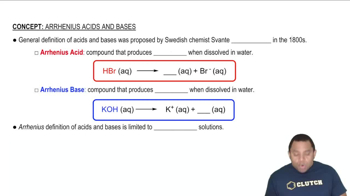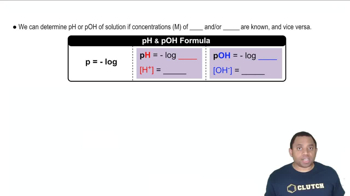Determine if each anion acts as a weak base in solution. For those anions that are basic, write an equation that shows how the anion acts as a base. a. Br– b. ClO– c. CN– d. Cl–
Ch.16 - Acids and Bases

Chapter 16, Problem 97
Determine the [OH–] and pH of a solution that is 0.140 M in F–.
 Verified step by step guidance
Verified step by step guidance1
Identify the relevant chemical equilibrium: The fluoride ion (F-) is the conjugate base of the weak acid HF, and it can undergo hydrolysis in water: \[ \text{F}^- + \text{H}_2\text{O} \rightleftharpoons \text{HF} + \text{OH}^- \].
Write the expression for the equilibrium constant (K_b) for the reaction: \[ K_b = \frac{[\text{HF}][\text{OH}^-]}{[\text{F}^-]} \].
Determine the value of K_b: Use the relationship \( K_w = K_a \times K_b \), where \( K_w = 1.0 \times 10^{-14} \) and \( K_a \) for HF is known from tables.
Set up an ICE table (Initial, Change, Equilibrium) to find the equilibrium concentrations of the species involved, assuming initial concentration of F- is 0.140 M and initial concentrations of HF and OH- are 0.
Solve for \([\text{OH}^-]\) using the K_b expression and the values from the ICE table, then calculate the pH using the relation \( \text{pH} = 14 - \text{pOH} \), where \( \text{pOH} = -\log[\text{OH}^-] \).

Verified video answer for a similar problem:
This video solution was recommended by our tutors as helpful for the problem above.
Video duration:
4mWas this helpful?
Key Concepts
Here are the essential concepts you must grasp in order to answer the question correctly.
Acid-Base Chemistry
Acid-base chemistry involves the study of the transfer of protons (H+) between species. In this context, fluoride ion (F-) acts as a weak base, which can accept protons from water, leading to the formation of hydroxide ions (OH-) and hydrofluoric acid (HF). Understanding this equilibrium is crucial for determining the concentration of OH- and the resulting pH of the solution.
Recommended video:
Guided course

Arrhenius Acids and Bases
Equilibrium Constant (Kb)
The equilibrium constant for the base dissociation reaction (Kb) quantifies the strength of a weak base. For fluoride, the reaction can be represented as F- + H2O ⇌ HF + OH-. The Kb value allows us to calculate the concentration of OH- produced in the solution, which is essential for determining the pH. Knowing Kb is vital for solving the problem accurately.
Recommended video:
Guided course

Equilibrium Constant K
pH and pOH Relationship
The pH scale measures the acidity or basicity of a solution, while pOH measures the concentration of hydroxide ions. They are related by the equation pH + pOH = 14 at 25°C. Once the concentration of OH- is determined, pOH can be calculated, and subsequently, pH can be derived. This relationship is fundamental for interpreting the results of the calculations.
Recommended video:
Guided course

pH and pOH Calculations
Related Practice
Textbook Question
1
views
Textbook Question
Determine whether each anion is basic or neutral. For those anions that are basic, write an equation that shows how the anion acts as a base. a. C7H5O2– b. I– d. F–
Textbook Question
Determine whether each anion is basic or neutral. For those anions that are basic, write an equation that shows how the anion acts as a base. c. NO3–
Textbook Question
Determine whether each cation is acidic or pH-neutral. For those cations that are acidic, write an equation that shows how the cation acts as an acid. a. NH4+
Textbook Question
Determine whether each cation is acidic or pH-neutral. For those cations that are acidic, write an equation that shows how the cation acts as an acid. b. Na+
